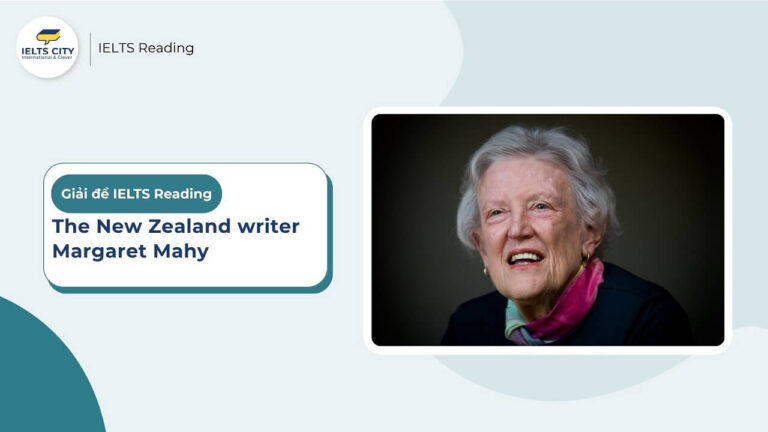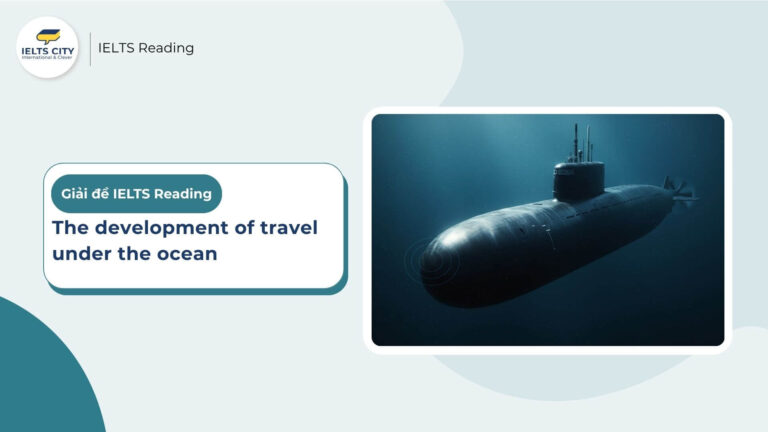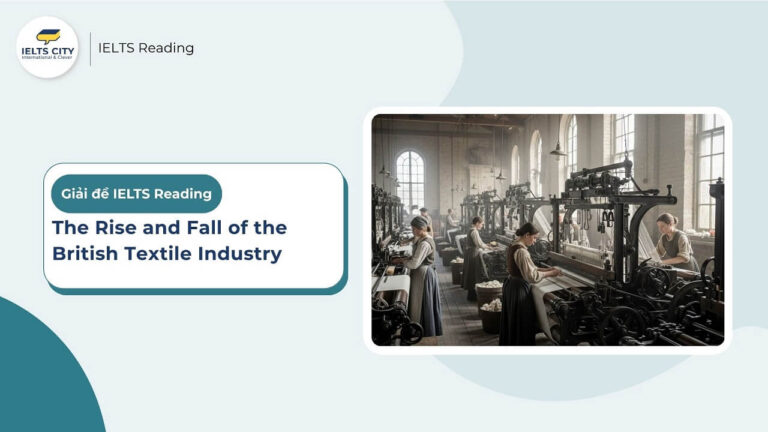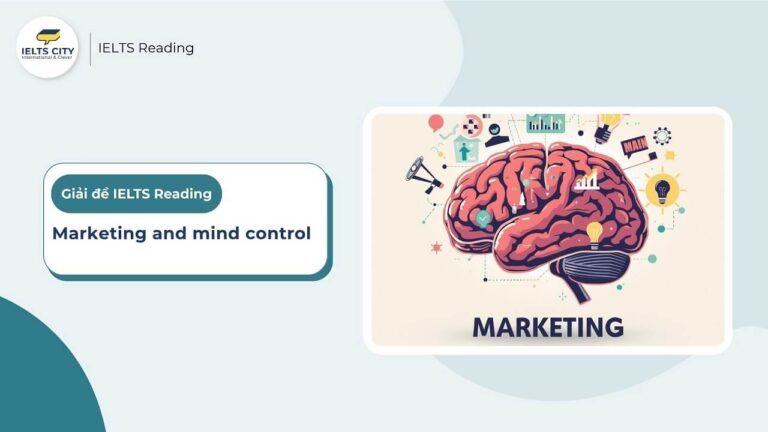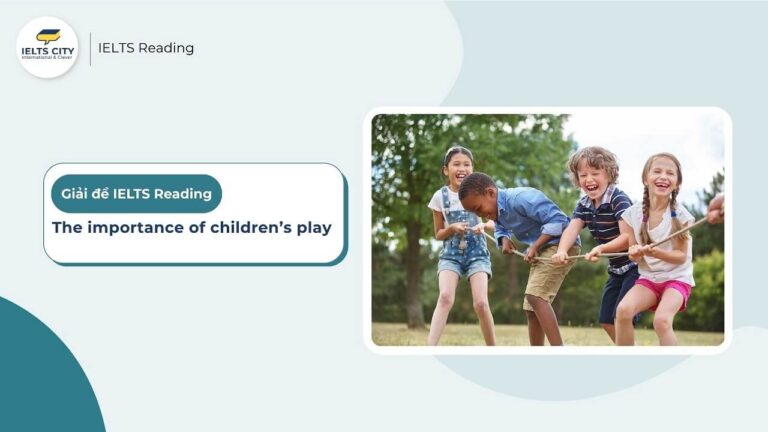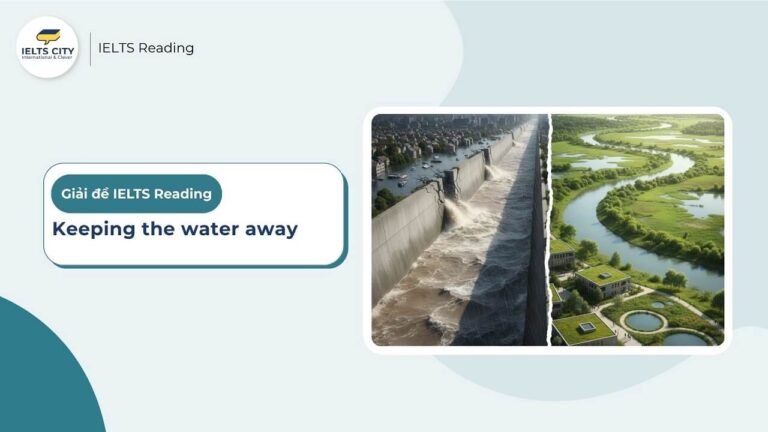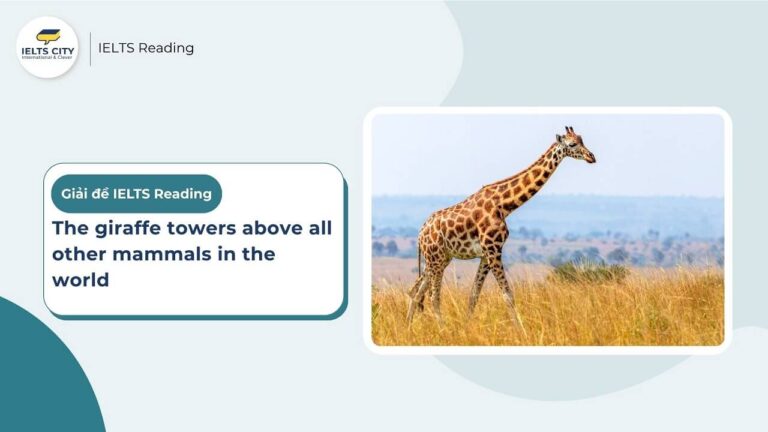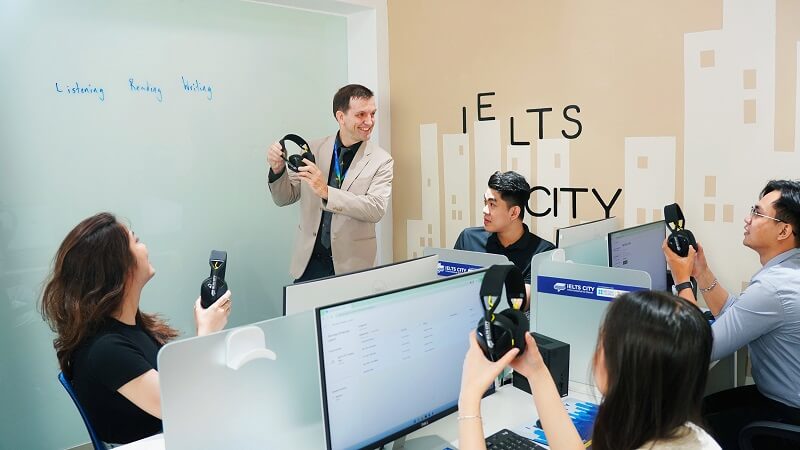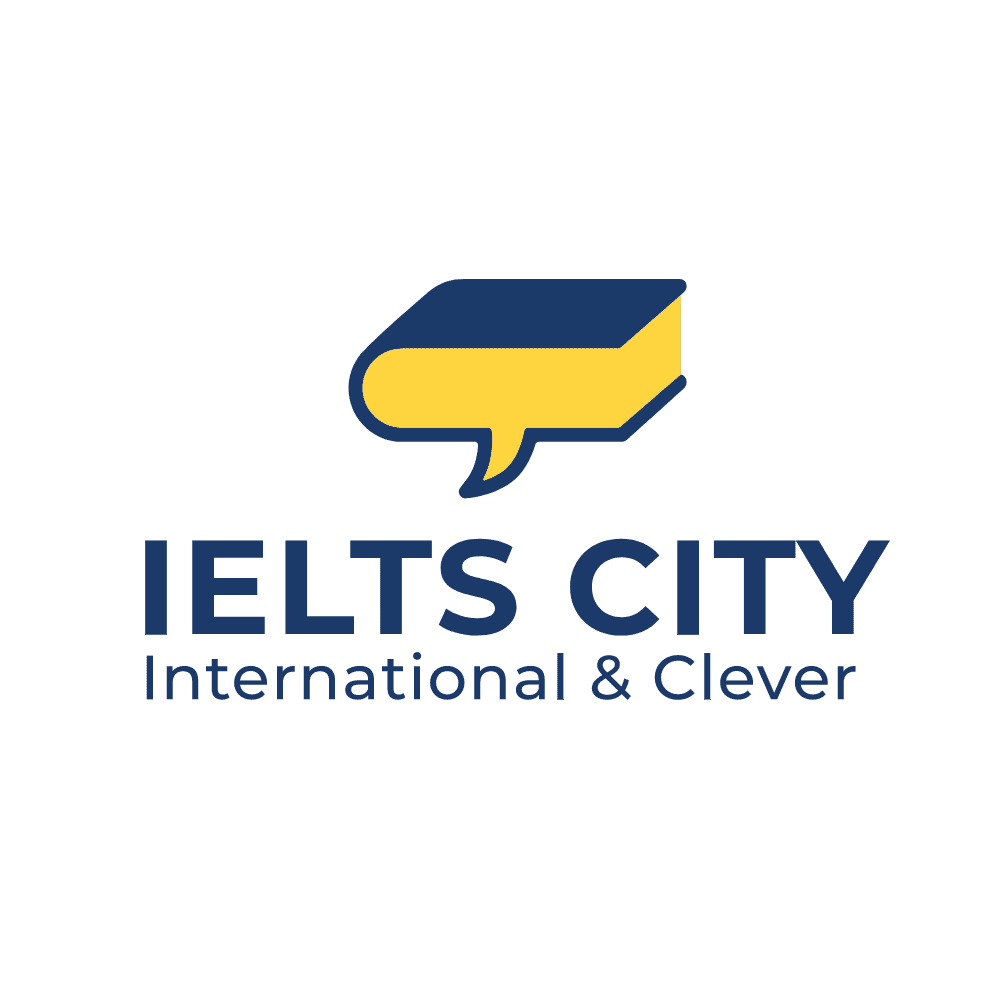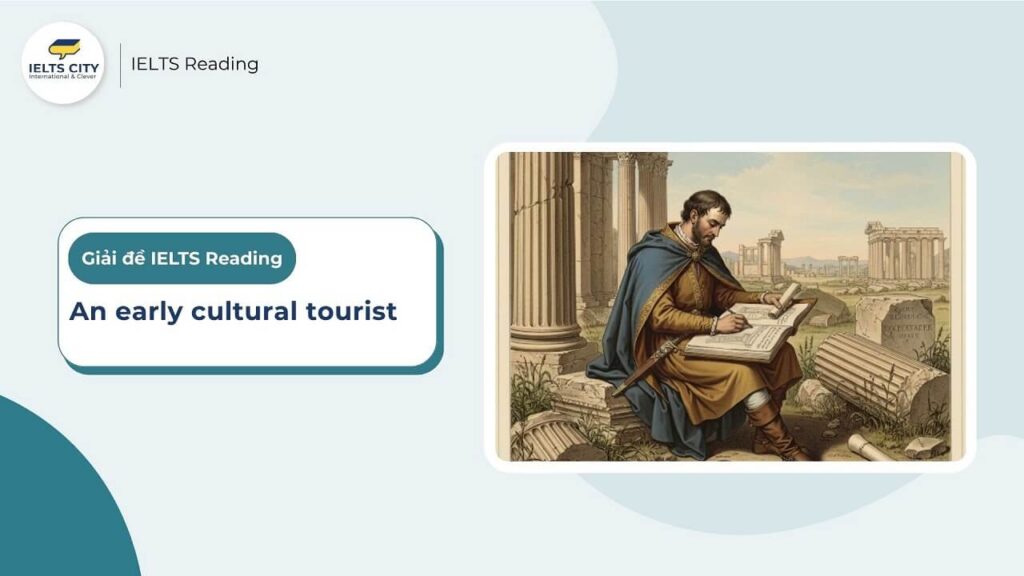
Nội dung chính
ToggleBài đọc
An early cultural tourist
In the 15th century, the Italian merchant Cyriacus of Ancona journeyed in search of the Mediterranean’s classical past. In doing so, he laid the groundwork for today’s cultural holidays.
Today we take it for granted that we travel around the world to admire the monuments of the past. We prepare for such trips by reading about what we are going to see, set out on the journey with a good idea of how we will get there and where we will stay and have a sense of what we will encounter on location. Cyriacus of Ancona (1391-1452), the first cultural tourist since antiquity, lacked these advantages when, in the first half of the 15th century, he sailed around the Mediterranean in search of the remains of Greek and Roman civilisations.
Cyriacus first became fascinated by ancient monuments while walking in his home city Ancona and looking at the marble arch, erected in AD 115, to the Roman Emperor Trajan. He suddenly saw the structure in a new light. He no longer saw it as just a familiar and generally overlooked landmark, but as a doorway to the wonders of ancient imperial Rome. Not many people of Cyriacus’s time were interested in historical travel, they generally ignored old buildings and structures, or worse, dismantled them for their building materials.
Cyriacus decided to see the world for himself and to record details of whatever other antiquities remained to be discovered. His training as a merchant did not prepare him for this vocation; he did not know ancient languages, history or art. However, he set out to solve these failings, first by learning Latin at the age of 30 and then adding ancient Greek. Having done this, he then set off on voyages around the Mediterranean to find, investigate and understand ancient cultures from their buildings, sculptures and inscriptions. Thus he became the first archaelogist and cultural tourist, predating other antiquarians by some 200 years.
Travel in the 15th century, however, was anything but simple or enjoyable. Overland journeys by foot or mule along bad roads, under constant threat from bandits, were bad; voyages by seas were even worse. When the weather cooperated, sailing went relatively smoothly, ships proceeded along coasts from one recognizable landmark to another. However, when there was no wind the ship did not move. Strong winds were no friends either, they drenched the ship with lashing waves and blew it off course. Water swamped the desk, splashed into the cabins and soaked mattresses, clothes and food. Remarkably, Cyriacus never complained about the miseries of travel. Optimistic by nature, he endured such hardships unafraid and saw opportunities where other people saw setbacks.
Among many of the important records made by Cyriacus was his crucial documenting, in 1431, of the remains of Cyzicus, an ancient Roman city that had relied on commerce for its financial success. He hired a local person to take him to site and then had to work out for himself the significance of the ruins he was looking at because there was no guidebook on ancient architecture to help him. Indeed, his contemporary knowledge about the ruins.
Cyzicus had been a splendid city in its prime. Unfortunately, the area was highly seismic and in AD 123 the city was so devastated by a major earthquake that, when the Roman Emperor Hadrian visited it the following year, he was so saddened that he decided to subsidise a campaign to reconstruct Cyzicus. He made a substantial donation for a new temple to the Roman go Jupiter. Cyriacus thought the ruined city was awe-inspiring. He found the remains of the temple and examined it in great detail, looking for clues in ancient texts to help him understand what he was seeing. He sketched the great doorway adorned with carved foliage and mythological characters. Cyriacu’s account of this temple is the only record of this building as in the following centuries it was entirely stripped of all its stonework and all that remains is its base.
Cyriacus also visited mainland Greece, in 1436, when no one went to Greece in order to see the country’s ancient ruins. One of his destinations was the sanctuary of Delphi. The ancient Greeks considered Delphi as being situated in the most beautiful spot in Greece. When Cyriacus arrived at the site of Delphi, however, he found war, earthquakes and avalanches had all but obliterated its ruins. Determined to find any ancient traces, Cyriacus spent six days walking all over the areas, peering at odd stone blocks sticking out of the ground, running his hands over inscriptions to trace fragments of words, and trying to puzzle out the few surviving structural remains. Climbing uphill towards the rocks that tower over the site, he came upon a theatre built into the slope. Soon after his visit, the site was buried by a rockslide and was not seen again until archaelogists began to excavate the area systematically in the late 19th century.
Cyriacus had hoped to visit Egypt and Ethipoia but he never got there. However, in his life he did record for posterity countless ancient monuments around the Mediterranean, paving the way for future archaelogists and cultural tourists.
Kiến thức cần nắm
Câu hỏi
Questions 1-6
Do the following statements agree with the information given in Reading Passage 1
In boxes 1-6 on your answer sheet, write
TRUE if the statement agrees with the information
FALSE if the statement contradicts the information
NOT GIVEN if there is no information on this
- Cyriacus was unable to research his journeys before he left.
- The Roman Emperor Trajan built the city of Ancona
- Respect for ancient architecture was widespread in the 15th century
- Cyriacus’s experience as a merchant gave him skills he needed to investigate the ancient world.
- Before leaving on his journey, Cyriacus studied ancient languages.
- Travelling by sea in the 15th century was easier than travelling on land.
- Cyriacus tried to make his fellow sea travelers more comfortable
Kiến thức cần nắm:
Questions 7-13
Complete the notes below.
Choose ONE WORD ONLY from the passage for each answer.
Write your answers in boxes 7-13 on your answer sheet.
Ancient Roman and Greek sites visited by Cyriacus
The city of Cyzicus
- the wealth of the city had come from 8…………
- 9…………to the ancient city ruins not available when visited by Cyriacus
- the city was destroyed by a powerful 10………… in AD 123
- a year later Emperor Hadrian supported a 11………… to rebuild the city
- Cyriacus found part of the temple, which was built in the time of Emperor
Hadrian, and made drawings of the 12………… to the temple and its decorative carvings
The sanctuary of Delphi
- by the 15th century Delphi had almost disappeared due to natural disasters and 13…………
Kiến thức cần nắm:
- Hướng dẫn cách làm SENTENCE COMPLETION trong IELTS Reading
Đáp án kèm phân tích
Questions 1-6: TRUE / FALSE / NOT GIVEN
Câu 1: Cyriacus was unable to research his journeys before he left.
- Đáp án: FALSE
- Giải thích: Câu này nói rằng Cyriacus không thể nghiên cứu cho chuyến đi của mình. Tuy nhiên, bài đọc lại chỉ ra rằng ông đã có sự chuẩn bị. Cụ thể, ông đã nỗ lực khắc phục những thiếu sót của mình bằng cách học hai ngôn ngữ cổ là Latin và Hy Lạp trước khi bắt đầu các chuyến hải trình.
- Vị trí và trích dẫn: Đoạn 4, câu 2-4.”However, he set out to solve these failings, first by learning Latin at the age of 30 and then adding ancient Greek. Having done this, he then set off on voyages around the Mediterranean…” (Tạm dịch: Tuy nhiên, ông đã bắt đầu khắc phục những thiếu sót này, đầu tiên bằng cách học tiếng Latin ở tuổi 30 và sau đó thêm tiếng Hy Lạp cổ. Sau khi làm xong việc này, ông mới bắt đầu các chuyến hải trình…)
Câu 2: The Roman Emperor Trajan built the city of Ancona.
- Đáp án: NOT GIVEN
- Giải thích: Bài đọc có đề cập đến Hoàng đế La Mã Trajan và thành phố Ancona. Tuy nhiên, nó chỉ nói rằng có một “marble arch” (khải hoàn môn bằng đá cẩm thạch) ở Ancona được xây dựng dành cho (to) Hoàng đế Trajan. Hoàn toàn không có thông tin nào nói rằng chính ông là người đã xây dựng cả thành phố Ancona.
- Vị trí và trích dẫn: Đoạn 3, câu 1.”Cyriacus first became fascinated by ancient monuments while walking in his home city Ancona and looking at the marble arch, erected in AD 115, to the Roman Emperor Trajan.” (Tạm dịch: Cyriacus lần đầu tiên bị cuốn hút bởi các di tích cổ khi đang đi bộ ở quê nhà Ancona và nhìn vào khải hoàn môn bằng đá cẩm thạch, được dựng lên vào năm 115 sau Công nguyên, dành cho Hoàng đế La Mã Trajan.)
Câu 3: Respect for ancient architecture was widespread in the 15th century.
- Đáp án: FALSE
- Giải thích: Câu này khẳng định rằng sự tôn trọng đối với kiến trúc cổ đã lan rộng trong thế kỷ 15. Điều này trái ngược hoàn toàn với thông tin trong bài đọc. Bài đọc nói rõ rằng người đương thời của Cyriacus thường “phớt lờ” các công trình cũ, hoặc tệ hơn là “phá dỡ chúng để lấy vật liệu xây dựng”.
- Vị trí và trích dẫn: Đoạn 3, câu 3.”Not many people of Cyriacus’s time were interested in historical travel, they generally ignored old buildings and structures, or worse, dismantled them for their building materials.” (Tạm dịch: Không nhiều người ở thời của Cyriacus quan tâm đến du lịch lịch sử, họ thường phớt lờ các tòa nhà và công trình cũ, hoặc tệ hơn, phá dỡ chúng để lấy vật liệu xây dựng.)
Câu 4: Cyriacus’s experience as a merchant gave him skills he needed to investigate the ancient world.
- Đáp án: FALSE
- Giải thích: Câu này cho rằng kinh nghiệm làm thương nhân đã cho Cyriacus kỹ năng cần thiết. Bài đọc lại nói điều ngược lại một cách rõ ràng: việc được đào tạo làm thương nhân “không hề chuẩn bị” cho ông những gì cần có cho công việc này.
- Vị trí và trích dẫn: Đoạn 4, câu 1.”His training as a merchant did not prepare him for this vocation; he did not know ancient languages, history or art.” (Tạm dịch: Việc đào tạo để trở thành một thương nhân không hề chuẩn bị cho ông theo đuổi sự nghiệp này; ông không biết các ngôn ngữ cổ, lịch sử hay nghệ thuật.)
(Câu 5 và 6 trên phiếu câu hỏi bị thiếu, tôi sẽ giải tiếp câu được đánh số tiếp theo trên phiếu)
Câu 5 trong danh sách: Before leaving on his journey, Cyriacus studied ancient languages.
- Đáp án: TRUE
- Giải thích: Thông tin này đã được dùng để giải thích cho câu 1. Bài đọc xác nhận rằng ông đã học tiếng Latin và Hy Lạp cổ trước khi lên đường.
- Vị trí và trích dẫn: Đoạn 4, câu 3-4.”…first by learning Latin at the age of 30 and then adding ancient Greek. Having done this, he then set off on voyages…” (Tạm dịch: …đầu tiên bằng cách học tiếng Latin ở tuổi 30 và sau đó thêm tiếng Hy Lạp cổ. Sau khi làm xong việc này, ông mới bắt đầu các chuyến hải trình…)
Câu 6 trong danh sách: Travelling by sea in the 15th century was easier than travelling on land.
- Đáp án: FALSE
- Giải thích: Bài đọc mô tả cả hai hình thức di chuyển đều rất tệ. Di chuyển trên đất liền (“Overland journeys”) thì “tệ” (bad), nhưng di chuyển bằng đường biển (“voyages by seas”) thì “thậm chí còn tệ hơn” (even worse). Do đó, đi biển khó khăn hơn chứ không phải dễ hơn.
- Vị trí và trích dẫn: Đoạn 5, câu 1.”Overland journeys… were bad; voyages by seas were even worse.” (Tạm dịch: Những chuyến đi trên bộ… thì tệ; những chuyến hải trình thậm chí còn tệ hơn.)
Câu 7 trong danh sách: Cyriacus tried to make his fellow sea travelers more comfortable
- Đáp án: NOT GIVEN
- Giải thích: Đoạn văn có mô tả cách Cyriacus đối mặt với những khó khăn trên biển: ông không bao giờ phàn nàn và luôn lạc quan. Tuy nhiên, bài đọc chỉ nói về thái độ cá nhân của ông, hoàn toàn không có thông tin nào đề cập đến việc ông có cố gắng giúp đỡ hay làm cho những người bạn đồng hành của mình cảm thấy thoải mái hơn hay không.
Questions 7-13: Complete the notes below (ONE WORD ONLY)
Câu 8: commerce
- Giải thích: Câu hỏi nói về sự giàu có (wealth) của thành phố Cyzicus đến từ đâu. Trong bài đọc, cụm từ “financial success” (thành công về tài chính) đồng nghĩa với “wealth”. Bài đọc nói rằng thành phố này “dựa vào thương mại (commerce) để có được thành công tài chính”.
- Vị trí và trích dẫn: Đoạn 6, câu 1.”…an ancient Roman city that had relied on commerce for its financial success.”
Câu 9: guidebook to the ancient city ruins not available when visited by Cyriacus
- Giải thích: Bài đọc cho biết lý do Cyriacus phải tự mình tìm hiểu ý nghĩa của các tàn tích là vì “không có sách hướng dẫn (guidebook) về kiến trúc cổ để giúp ông”.
- Vị trí và trích dẫn: Đoạn 6, câu 2.”…because there was no guidebook on ancient architecture to help him.”
Câu 10: earthquake
- Giải thích: Ghi chú nói rằng thành phố bị phá hủy bởi một thứ gì đó “mạnh mẽ” (powerful). Bài đọc mô tả rằng thành phố đã bị “tàn phá nặng nề” (so devastated) bởi một “trận động đất lớn” (major earthquake).
- Vị trí và trích dẫn: Đoạn 6, câu 3.”…in AD 123 the city was so devastated by a major earthquake that…”
Câu 11: campaign
- Giải thích: “A year later” (một năm sau) tương ứng với “the following year”. “Supported” (hỗ trợ) tương ứng với “subsidise” (trợ cấp). Hoàng đế Hadrian đã trợ cấp cho một “chiến dịch” (campaign) để xây dựng lại thành phố.
- Vị trí và trích dẫn: Đoạn 6, câu 4.”…he decided to subsidise a campaign to reconstruct Cyzicus.”
Câu 12: doorway
- Giải thích: Câu hỏi muốn biết Cyriacus đã vẽ bộ phận nào của ngôi đền. Bài đọc nói rằng ông đã “phác thảo cánh cổng lớn” (sketched the great doorway).
- Vị trí và trích dẫn: Đoạn 6, câu 6.”He sketched the great doorway adorned with carved foliage and mythological characters.”
Câu 13: avalanches
- Giải thích: Câu hỏi đã nhóm earthquakes và avalanches vào chung một cụm là “natural disasters” (thảm họa thiên nhiên) và War (chiến tranh) không phải là từ thiên nhiên.
- Vị trí và trích dẫn: Đoạn 7, câu 2.”…he found war, earthquakes and avalanches had all but obliterated its ruins.”
Cập nhật đề thi thật Reading mới nhất tại:


